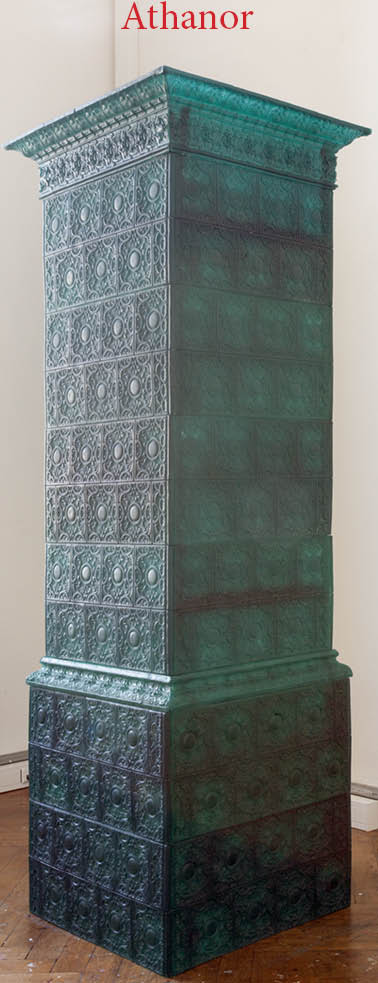
Text in Catalog: EnergieWendeKunst by Svetlana Kibke, 2015
„At the moment of entering the exhibition space, the visitor’s attention is attracted by a famililar noise: it is ths sound of a fan on busy computer. However, the object associated with this soundscape remains nowhere to be seen.
A green masondry stove, to scale, reveals itself of the observer. Ostensibly a familiar picture, resonating warmth and coziness, even disconcerting.
When nearing the object it becomes clear: the ventilation sounds are coming from the interior of the stolve. Its surface feels warm to be touch, although there is no visibel opening for fueling. Inevitably, the question of energy source arises, but for the first moment a plausible explanation cannot be found.
Five servers are running in the interior of the stove, heating it with their lost heat. They are part of a research project. On the artist’s website page the users themselves can fuel the stoves through their clicks. The web page reveal rather the required time for computing the calculation of the processin unit, which considered an indication of how much energy is consumed. Every 15 seconds the information about the temperature of the servers is updated.
In digital modernity, the use of computers and the internet has become so common that the implicit complex processing power and resources are barely registered anymore. The ventilation sounds made by computers and servers si commonplace, the high consumption of energy barely perceived.
Each Google search consumes as much energy as an energy-saving lightbulb does per hour. The energy consumption of data centres and server farms accounts currently for two per cent of energy consumed worldwide. As much energy is required for cooling computers as for their operation. An immense use of resources that often remains concealed. The idea behind the work originated in 2012 through a crowd funding project, that later advanced to start-up. The company offers a cloud server that utilizes resulting lost heat for warming buildings and provision of hot water.
In this manner, the energy for server cooling as well as conventional heating is saved. As a model for appearance of the stove, Roswitha Maul was inspired by a 19th century bottle-green masonry stove by Meißen. She copied the relief and cast it in transparent synthetic resin.
From the creation of the first masonry stove in antiquity, the generation of heat ans energy remains an essential component of human history. The title, Athanor, makes reference to the stove used by the alchimists for creation of the philosopher’s stone. The search for elements that could turn base metal to gold represented only the basic idea of universal substance with the power to transform one form of matter into another.
In this context, energy becomes an essential driver ans represents the basis for history, present ans future of civilization. Roswitha Maul’s work unites all three temporal levels with basic human needs for heat, comfort ans communication.
The stove becomes the meeting point, provides warmth ans symbolises a network that unites the whole world: the Internet. With Athanor Roswitha Maul reactivates in the public consciousness the output and the energy demand for the production of this network. At the same time, she increases the awareness of the significant potential associated for example with the sensible utilization of server loss heat. Athanor is a sculpture, a stove, and an object of experimentation, which appears both cosy and paradoxical, while leaving latitude for innovation.
A native of Leipzig, tha artist completed her education as a ceramist and then studied sculpture ans plastics with Prof. Wilhelm Mundt, Prof. Martin Honert and Prof. Eberhard Bosslet at the Academy of Fine Arts in Dresden.
In her work she often combines traditional and modern elements with one another, as seen in the work Vereinsmühle (2015) in which the blades of a traditional wooden windmill were replaced by the rotor blades of a wind turbine. The work Lampyrida Maxima (2012) adresses bioluminescense and the potentional to use the luminous power of glow worms to produce light.
Roswitha Maul’s oeuvre is marked by the approach of joning the old to the new, staging contrary materials and forms, but also preserving the trusted and the lost, creating from these new ideas.“